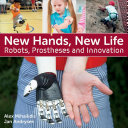2018 School Spending Survey Report
New Hands, New Life: Robots, Prostheses and Innovation
MIHAILIAIS, Alex & . 64p. glossary. index. photos. Firefly. Oct. 2017. Tr $19.95. ISBN 9781770859692; ebk. $9.95. ISBN 9781770859913.
COPY ISBN
VERDICT A comprehensive, STEM-related update to the health and wellness sections of nonfiction collections.
RELATED
ALREADY A SUBSCRIBER? LOG IN
We are currently offering this content for free. Sign up now to activate your personal profile, where you can save articles for future viewing





Be the first reader to comment.
Comment Policy:
Comment should not be empty !!!